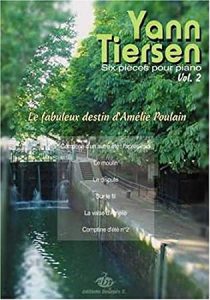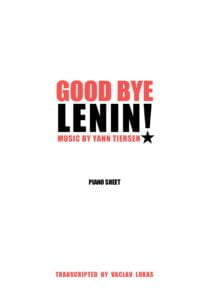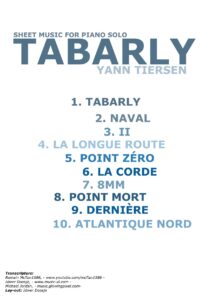Come join us now, and enjoy playing your beloved music and browse through great scores of every level and styles!
Can’t find the songbook you’re looking for? Please, email us at: sheetmusiclibrarypdf@gmail.com We’d like to help you!
Happy birthday, Yann Tiersen, born in this day in 1970

Best Sheet Music download from our Library.

Please, subscribe to our Library.
If you are already a subscriber, please, check our NEW SCORES’ page every month for new sheet music. THANK YOU!

Yann Tiersen: The Breton Alchemist of Sound – Beyond Amélie’s Reverie
Browse in the Library:
Or browse in the categories menus & download the Library Catalog PDF:
Yann Tiersen is a name that instantly conjures evocative, melancholic melodies, often inextricably linked to the whimsical charm of Jean-Pierre Jeunet’s film Amélie. Yet, to confine this Breton composer, multi-instrumentalist, and sonic architect to that single, albeit magnificent, score is a profound disservice. Tiersen is a restless artist, a meticulous craftsman, and a genre-defying explorer whose work traverses minimalist classical, experimental rock, traditional Breton folk, electronica, and avant-garde soundscapes. His journey is one of constant reinvention, rooted in the rugged landscapes of his homeland yet reaching towards universal emotional resonance. This article delves deep into the life, music, influences, and enduring legacy of this unique musical voice.
I. Biography: From Punk Roots to Sonic Landscapes
Born on June 23, 1970, in Brest, Brittany, France, Yann Pierre Tiersen’s formative years were shaped by the distinct cultural identity and wild Atlantic coastline of his region. Music entered his life early, though not through the traditional conservatoire path one might assume. He began studying violin at the age of 4 and piano at 6 at the Nantes Conservatoire, but institutional rigidity chafed against his burgeoning independent spirit.
- The Punk Catalyst: As a teenager, Tiersen rebelled against classical formalism, finding liberation and raw expression in punk rock. Bands like The Stooges and Joy Division became his anthems. Crucially, he taught himself guitar, embracing the DIY ethos. He formed several punk bands, playing electric guitar with the intensity and immediacy the genre demanded. This period was fundamental – it instilled a fierce independence, a disregard for convention, and a love for the visceral power of amplified sound that would later resurface in unexpected ways.
- The Instrumental Polymath: While punk provided the fire, Tiersen never abandoned his instrumental foundation. He voraciously explored other instruments, becoming proficient on accordion (a staple of Breton folk music), mandolin, toy piano, harpsichord, melodica, banjo, and various other stringed and keyboard instruments. This self-taught mastery allowed him to develop a highly personal musical language, unbound by the technical limitations or stylistic expectations associated with any single instrument.
- Early Solo Work & Breakthrough (1990s): Moving to Rennes, Tiersen began composing instrumental pieces, initially for small theatre productions. His debut album, La Valse des Monstres (1995), recorded largely at home, was a revelation. It showcased his unique blend of influences: the cyclical structures of minimalism (Philip Glass, Steve Reich), the harmonic melancholy of French chanson and Erik Satie, the raw energy of punk, and the modal melodies of Breton folk. Tracks like “Monochrome” established his signature sound – simple, poignant melodies carried by accordion or piano, underpinned by driving, repetitive rhythms, often played on prepared piano (with objects placed on the strings to create percussive effects). This was followed by Rue des Cascades (1996), further refining his style and gaining critical acclaim in France. Le Phare (1998) marked a significant step forward, both artistically and in terms of reach. Its richer production and emotionally potent tracks like “La Noyée” and “Sur le Fil” began attracting international attention, particularly after the latter was used in the French film Alice et Martin.
- Amélie and Global Acclaim (2001): The turning point arrived with Jean-Pierre Jeunet’s Le Fabuleux Destin d’Amélie Poulain (2001). Jeunet, already a fan, used existing Tiersen pieces (“La Valse d’Amélie” was actually “La Valse des Monstres” reworked; “Comptine d’un autre été: L’Après-midi” from Rue des Cascades) alongside newly composed material. The soundtrack became a global phenomenon. Its infectious charm, bittersweet nostalgia, and undeniable Gallic character perfectly captured the film’s magic. Tiersen won a César Award (French Oscar) and achieved worldwide fame virtually overnight. However, this sudden association as “the Amélie composer” became a complex burden.
- Rejection of the Limelight and Artistic Evolution (2000s – Present): Uncomfortable with the mainstream celebrity and the typecasting that followed Amélie, Tiersen actively distanced himself. He retreated to the remote Île d’Ouessant (Ushant) off the Breton coast, seeking isolation and a return to his artistic core. His subsequent albums reflected this:
- L’Absente (2001): A darker, more complex work featuring collaborations (Lisa Germano, Neil Hannon of The Divine Comedy) and exploring themes of absence and loss. It signaled his refusal to repeat the Amélie formula.
- Les Retrouvailles (2005): Continued the collaborative spirit, incorporating vocals more prominently (including Elizabeth Fraser of Cocteau Twins) and experimenting with denser arrangements.
- The Experimental Turn: Albums like Dust Lane (2010) and Skyline (2011) marked a radical shift. Punk energy resurfaced aggressively alongside analog synthesizers, distorted guitars, complex rhythms, and layered electronic textures. Tiersen embraced noise, dissonance, and a more abstract, rock-infused sound, confounding expectations but demonstrating his restless creativity.
- Return to Roots & Ecology: EUSA (2016) was a deeply personal, almost geographical album. Each track is named after a location on Ushant, and the music reflects the specific landscapes and moods of the island, recorded outdoors. ALL (2019) continued this connection to place, recorded in Iceland and Ushant, blending field recordings with acoustic and electronic elements, often featuring a revolving ensemble of musicians. Portrait (2022) offered a unique concept – a collection of live recordings from his 2021 tour, but presented as a studio album, capturing the spontaneous energy of performance. His latest, 11 5 18 2 5 18 (2024), continues his exploration of place and memory, inspired by his time in Iceland and reflecting on environmental fragility.
Throughout his career, Tiersen has maintained his independence, often releasing music on his own label or through small, artist-focused imprints. He remains deeply connected to Brittany, politically engaged (particularly on environmental and Breton cultural autonomy issues), and committed to artistic integrity above commercial success.
II. Music Style: An Elusive Alchemy
Defining Yann Tiersen’s style is challenging because it deliberately evades categorization. It’s a constantly evolving synthesis:
- Melody First: Above all, Tiersen is a melodist. His compositions often hinge on simple, unforgettable, deeply poignant melodies. These melodies frequently possess a folk-like quality – singable, modal (often Dorian or Mixolydian), and imbued with a sense of longing or bittersweet nostalgia, even within his most experimental work.
- Minimalist Foundation: Repetition is a core structural element. Short melodic phrases, rhythmic ostinatos (repeating patterns), and chord sequences are looped, layered, and gradually evolve. This creates a hypnotic, trance-like quality reminiscent of American minimalism, but imbued with a distinctly European emotional weight.
- Instrumental Palette as Identity: Tiersen’s sound is inseparable from his choice and treatment of instruments. He masterfully blends:
- Acoustic Nostalgia: Piano (often prepared), accordion, violin, mandolin, harpsichord, toy piano, melodica. These evoke tradition, chamber music, and folk.
- Electric Edge: Distorted guitar, bass guitar, synthesizers (analog and digital), drum machines. These introduce grit, noise, and modern textures.
- Percussive Texture: Found sounds, prepared piano as percussion, unconventional rhythmic elements. This adds complexity and organic feel.
- Harmonic Language: While capable of complex harmony, Tiersen often favors simplicity and modal ambiguity:
- Modal Harmony: Drawing heavily from Breton folk traditions, he frequently uses modes (Dorian, Mixolydian, Aeolian) rather than strict major/minor keys. This creates open, sometimes unresolved, evocative soundscapes.
- Diatonic Clarity: Many of his most famous pieces use straightforward diatonic chord progressions (chords built from the notes of a single scale), but rendered profound through melodic contour and instrumentation.
- Drone and Pedal Points: Sustained bass notes (drones) or repeated bass figures (pedal points) are common, providing a static foundation over which melodies and harmonies shift, creating tension and release.
- Unexpected Shifts: Even within simple frameworks, he employs surprising harmonic turns or dissonances that add depth and prevent predictability. Minor-to-major shifts are a particularly effective emotional tool.
- Rhythmic Drive: While some pieces are rubato and free, many feature strong, often insistent, repetitive rhythms. These can be folk-derived (waltzes, marches), minimalist motorik beats, or driving rock/punk pulses. This rhythmic energy is crucial to avoiding sentimentality and grounding the music.
- Emotional Resonance: Ultimately, Tiersen’s music connects through its profound emotional directness. It can be melancholic, joyful, nostalgic, angry, serene, or unsettling – often within the same piece. It bypasses intellectual barriers to speak directly to the listener’s core feelings.
III. Improvisation, Licks, and Harmonic Progressions
Tiersen’s approach to improvisation and “licks” differs significantly from jazz or blues traditions:
- Improvisation in Tiersen’s World:
- Compositional Tool: Improvisation is often the starting point for Tiersen. He might improvise on piano, accordion, or guitar to generate melodic ideas, rhythmic patterns, or harmonic textures that later become fixed compositions. The final piece retains the spontaneous feel of the initial idea but is meticulously crafted.
- Live Performance Evolution: While his compositions are largely set, Tiersen allows for significant interpretation and variation in live settings. Tempi might shift, dynamics are explored dramatically, textures are thickened or thinned, and extended instrumental passages might emerge, particularly on tracks from his more experimental albums. He treats the studio version as a blueprint, not a rigid template. His Portrait album is a testament to this live reinvention.
- Textural Improvisation: Rather than virtuosic soloing, improvisation might involve manipulating sound in real-time using effects pedals (for guitar, synths, or even accordion), layering loops, or reacting to the acoustics of a venue or the interplay with his band.
- “Licks” – The Building Blocks: Tiersen doesn’t rely on flashy, pre-learned licks in the conventional sense. Instead, his music is built from recurring melodic and rhythmic motifs:
- Piano/Accordion Figures: Rapid, repeating arpeggios (e.g., the iconic right-hand figure in “Comptine d’un autre été”); simple, poignant stepwise melodies often doubled in octaves; waltz patterns with a slight lilt.
- Guitar Textures: In his rock-oriented work, he uses distorted, rhythmic chordal riffs (often power chords or open voicings with drones), repetitive single-note patterns, and textural noise rather than bluesy solos. Think driving, interlocking parts reminiscent of post-punk or krautrock.
- Rhythmic Ostinatos: Short, repetitive rhythmic patterns on piano (prepared or not), percussion, or bass that form the bedrock of a piece (e.g., the left-hand pattern in “La Valse d’Amélie”).
- Chord Progressions: Deconstructing the Tiersen Sound:
- Simplicity with Depth: Many iconic pieces use deceptively simple progressions:
- “Comptine d’un autre été: L’Après-midi“: Primarily oscillates between Em and C (vi-IV in G major, but feels modal due to emphasis). The power lies in the stark piano melody, the rhythmic drive of the left hand, and the unresolved tension between the two chords.
- “La Valse d’Amélie“: Essentially a waltz circling around Am and G (i-VII in A minor). The accordion timbre, the waltz rhythm, and the melancholic melody transform this simple shift.
- “Sur le Fil“: Based on a repeating cycle: Am – G – F – G (i-VII-VI-VII in A minor). The relentless repetition and building instrumentation create intensity.
- “Porz Goret” (EUSA): Uses a drone (D) throughout, with piano chords shifting above (D, G/D, Bm/D, A/D). Modal ambiguity (D Mixolydian/Dorian feel) and the grounding drone evoke the Breton landscape.
- Modal Colors: Progressions often avoid traditional cadences (V-I) and favor modal movement. A common sound is moving between the tonic minor chord (i) and the major chord built on the flattened seventh degree (bVII – e.g., Am to G). This creates a bittersweet, open feeling.
- Drone Foundation: Pieces like “Monochrome” or “Porz Goret” rely heavily on a sustained bass note (drone) over which harmonies change, creating a sense of stasis and gradual evolution.
- Unexpected Juxtapositions: Even in later, more complex work, Tiersen might place a simple, folk-like melody over a dissonant, distorted guitar bed or an electronic texture, creating striking contrasts.
- Simplicity with Depth: Many iconic pieces use deceptively simple progressions:
IV. Influences: A Diverse Tapestry
Tiersen’s sound is a unique amalgamation drawn from a wide range of sources:
- Breton Folk Music: The bedrock. The modal melodies, the use of accordion and violin, the rhythmic structures of dances, the pervasive sense of melancholy and connection to landscape are fundamental.
- French Chanson and Classical: The melodic elegance and emotional directness of artists like Georges Brassens or Jacques Brel; the harmonic simplicity and eccentricity of Erik Satie; the impressionistic textures of Debussy or Ravel.
- Minimalism: The repetitive structures, gradual processes, and hypnotic qualities of Steve Reich, Philip Glass, and Terry Riley.
- Punk Rock: The raw energy, DIY ethos, rejection of convention, and use of distorted guitar from bands like The Stooges, Joy Division, and Crass.
- Post-Rock & Experimental: The textural explorations, dynamic shifts, and blending of rock instrumentation with non-rock elements akin to bands like Godspeed You! Black Emperor, Mogwai, or Rachel’s. Also, the avant-garde use of sound.
- Electronic Music: From early pioneers like Kraftwerk to contemporary electronic producers, influencing his use of synthesizers, drum machines, sampling, and studio-as-instrument techniques, especially post-2010.
- Film Music: While he scores films, he’s also influenced by the narrative power and atmospheric depth of film composers (though he often avoids traditional orchestral Hollywood tropes).
V. Legacy: More Than a Soundtrack
Yann Tiersen’s legacy is multifaceted and significant:
- Redefining “French” Music: He broke away from clichés, creating instrumental music that was unmistakably French (particularly Breton) in sensibility yet modern, accessible, and internationally resonant. He proved instrumental music could carry profound emotional weight and narrative without words.
- The Amélie Phenomenon: While he moved beyond it, the soundtrack remains a cultural touchstone. It introduced millions worldwide to his music and demonstrated the immense power of well-integrated film scoring. It rekindled interest in accordion and “French” sounds in popular culture.
- Genre Fluency as a Virtue: Tiersen stands as a powerful example of an artist who successfully and authentically blends seemingly disparate genres – folk, classical, punk, electronica, minimalism – creating a sound entirely his own. He inspires musicians to look beyond stylistic boundaries.
- The Independent Ethos: His career path – from DIY beginnings, through massive fame, to deliberate retreat and continued independent exploration – is a model of artistic integrity. He prioritizes creative freedom over commercial pressures.
- Emotional Soundscaping: He masters the creation of distinct sonic atmospheres that evoke specific places, memories, and complex emotional states. His later work, especially EUSA and ALL, are powerful examples of music as a form of sonic geography.
- Influence on New Generations: His blend of acoustic intimacy, melodic immediacy, and willingness to incorporate electronic/experimental elements has influenced countless composers and artists in modern classical, post-rock, neofolk, and film scoring.
VI. Major Works, Filmography, and Discography
- Key Studio Albums:
- La Valse des Monstres (1995)
- Rue des Cascades (1996)
- Le Phare (1998) – Breakthrough
- Tout Est Calme (1999)
- L’Absente (2001) – Post-Amélie evolution
- Les Retrouvailles (2005)
- Dust Lane (2010) – Experimental rock turn
- Skyline (2011)
- ∞ (Infinity) (2014)
- EUSA (2016) – Ushant soundscapes
- ALL (2019)
- Portrait (2022) – Live recompositions
- 11 5 18 2 5 18 (2024)
- Significant Film Scores:
- La Vie Rêvée des Anges (1998) – Early recognition
- Le Fabuleux Destin d’Amélie Poulain (2001) – Global phenomenon (César Award)
- Good Bye Lenin! (2003)
- Tabarly (2008) – Documentary
- L’Écume des jours (Mood Indigo) (2013)
- Other Notable Works:
- Collaborations: With artists like Dominique A, Natacha Régnier, Shannon Wright, Elizabeth Fraser, John Parish, Gruff Rhys.
- Live Albums: Black Session (1999), C’était ici (2002), On Tour (2006), Dust Lane Live in Reykjavik (2011).
- Soundtrack Albums: Beyond his major films, scores for documentaries and shorts.
- Kerber (2021): A benefit album for the people of Ukraine.
- Most Known Compositions:
- “Comptine d’un autre été: L’Après-midi”
- “La Valse d’Amélie” (based on “La Valse des Monstres”)
- “La Noyée”
- “Sur le Fil”
- “J’y suis jamais allé”
- “Monochrome”
- “Porz Goret”
- “K
Yann Tiersen Discography
Soundtracks
Yann Tiersen: ‘Pour Amélie’ Piano Music (Full Album) played by Jeroen van Veen.
Tracklist:
00:00:00 Comptine dun autre été: laprès midi
00:02:42 Comptine dété No.2 00:05:09 Comptine dété No.3
00:07:40 Le vieux en veut encore
00:09:20 Toujours la
00:10:45 Comptine dété No.1 00:13:07 La piece vide 00:15:02 La dispute 00:17:19 Sur le fil 00:22:34 Les jours heureux 00:24:54 chute 00:30:57 Labsente
00:34:17 Le retour
00:36:09 La valse d`Amélie
00:38:52 Le Moulin
00:42:32 Le matin
00:44:39 La plage
00:46:52 Les retrouvailles
00:49:13 La jetee
00:50:16 Tabarly
00:53:02 8 mmm
00:55:27 Point Zero
00:58:34 Summer 78
01:02:34 Coma
01:04:33 Childhood (1)
01:06:27 From Prison to Hospital
01:07:51 Mother
01:09:34 Watching Lara
01:11:26 Selling Dishes
01:12:17 First Rendez-Vous
01:13:50 The Decant Session
01:14:43 Lara’s Castle
01:16:45 The Deutsch Mark is Coming
01:18:01 I saw Daddy today
01:20:21 Birthday Preparations
01:22:07 Good Bye Lenin
01:27:37 Childhood (2)
01:30:21 Letters
01:31:53 Mother’s Journey
01:33:27 Preparations for the Last TV Fake
01:36:39 Mother Will Die
01:40:09 Father is Late
01:41:51 Father and Mother
01:45:20 Finding the Money
01:46:52 Summer 78
Artist:
Jeroen van Veen (piano)
